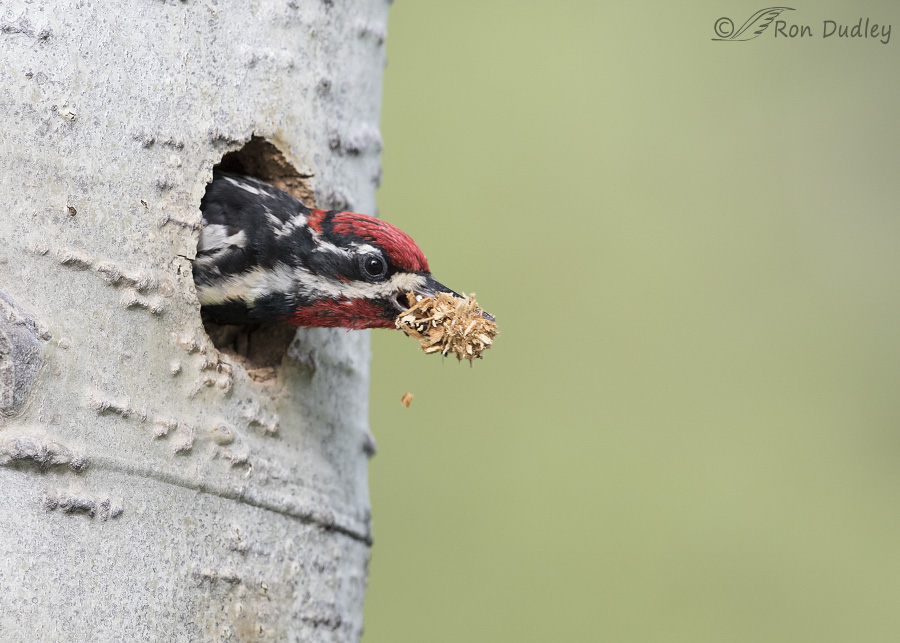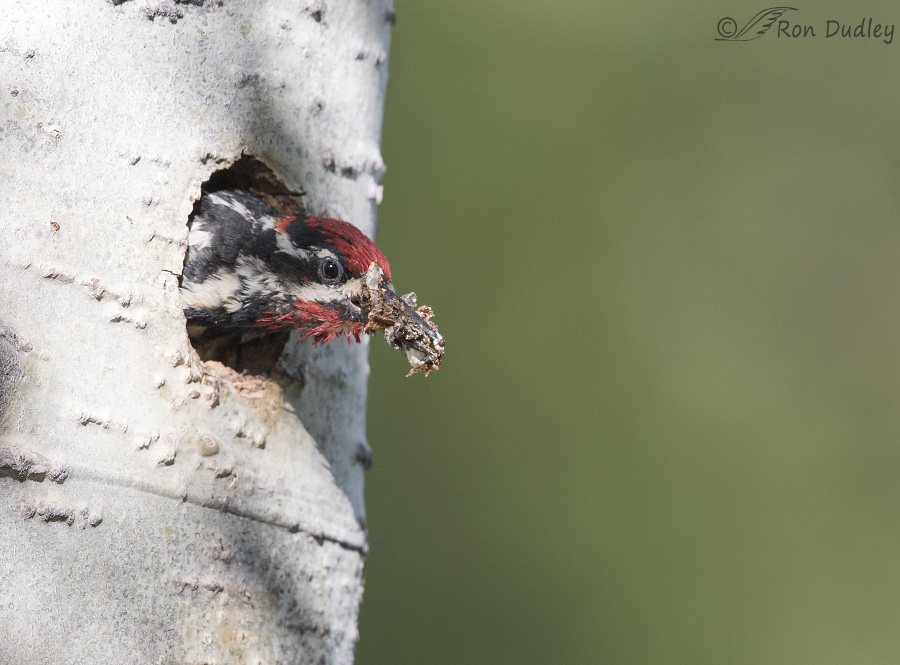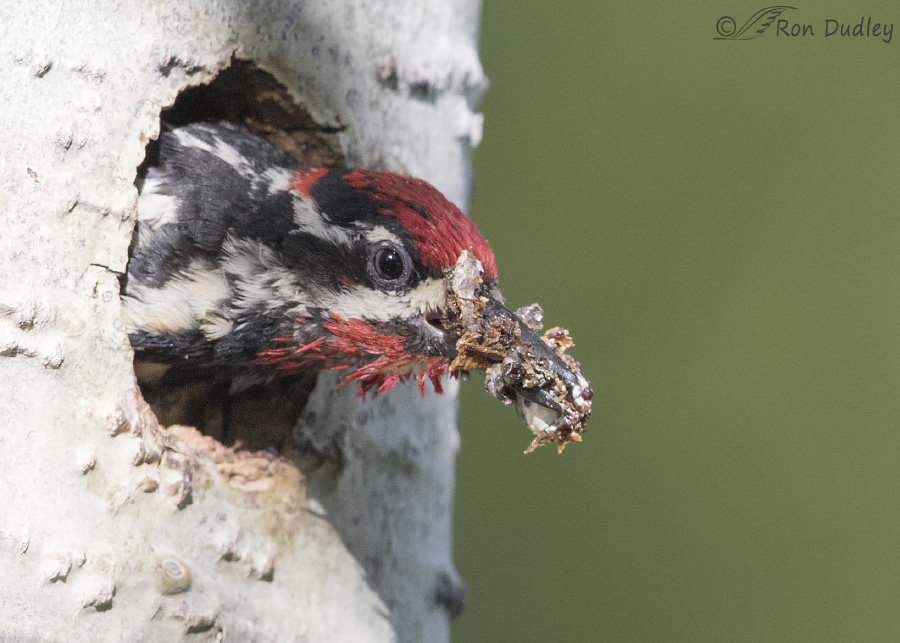There are obvious advantages to raising your family in a nesting cavity but doing so also has its challenges.

1/800, f/5, ISO 800, Canon 7D Mark II, Canon EF 500mm f/4L IS II USM, not baited, set up or called in
About a month ago I photographed a pair of nesting Red-naped Sapsuckers at their nest cavity in an aspen tree in the Uinta Mountains (as always I was very careful not to disturb them). The work involved with keeping the chicks fed and the cavity clean is enormous. The eggs are laid on a bed of wood chips created by pecking the sides and bottom of the cavity (a nice, clean environment) but as soon as the chicks hatch sanitation becomes an issue because they have no choice but to defecate inside the cavity.
Feeding visits to the chicks by the parents occur about every 7 minutes for the first 5-6 days but after that they increase to about every 2 minutes from dawn to dusk – talk about a frenetic schedule! And as the male leaves he often removes chick wastes in the form of fecal sacs and excrement-soaked wood chips (he usually drops them at the base of a single nearby tree called a “sanitation post”). Notice that this load of chips looks pretty clean. I suspect that’s because the chicks (I could hear them inside the cavity) were still fairly small and producing relatively little waste.

1/1250, f/5.6, ISO 800, Canon 7D Mark II, Canon EF 500mm f/4L IS II USM, not baited, set up or called in
But eight days later with the chicks significantly larger and producing more wastes the sanitation trips had become much messier. Here the male has a beak-full of waste-laden and discolored chips and a single fecal sac. At this stage Hippoboscid flies (louse flies – obligate parasites of mammals and birds) are frequently associated with the nest cavities and I often see them near the nest entrance.

A big crop of the previous image allows us to better see that the adults are beginning to show the wear and tear on some of their plumage caused by their hectic schedule. All that activity inside the cavity with the growing chicks when combined with the messiness of the sanitation trips can make them look pretty scruffy.
The single biggest impression I get while observing nesting sapsuckers is the incredible amount of work involved in raising a family – it makes me tired just to watch them.
Ron
Note: My beloved Antelope Island is on fire! They suspect it was caused by a lightning strike last night (now they’re saying it may have started on the back side of the island Thursday night but no one saw or reported it). So far (as of 7 AM Mountain Time) 8000 acres of the 28,000 acre island have burned and the fire is still going strong.
This is simply dreadful!


Reading this makes me happy my kids are not on a sapsucker schedule.
I’ll bet, Bridger. Especially now with all you’ve got going on…
I’m so sorry Ron. I’ve never seen your land except through your eyes. Diana
It’s going to look very different now, Diana. For a good long time…
I read Mia’s post about the fires shortly before I got to yours. I am so sorry, and hope it can be brought under control quickly. Fires are a fact of our summer, but are too often deliberately lit.
Love those incredibly hard-working sapsuckers. And don’t have their perfectly valid excuse for my own scruffiness.
Last I heard the fire was still growing, EC. It’s a disaster.
What’s Mia’s blog called I’d like to check it out?
Mia’s blog is listed on Ron’s sidebar, with a link. Mia McPherson OnTheWingPhotography.
I just can’t imagine how much work that is for the parents. I too hope the Antelope fire is contained soon.
We can only hope, April…
Amazing images of a very busy life as a woodpecker. Very sorry to hear about Antelope Island Ron. Hoping for rain and no wind (yeah, I know…, but who knows). I am guessing that they will let the fire burn, but protect structures?
Nope, they’re fighting it, Ed. It’s my guess that one of the reasons they are is to try to keep the cheat grass under some semblance of control. Every time an area like this burns it gives the invasive cheat grass an advantage over native species.
Cheat grass is a never ending battle here and it does take advantage of bare spots!
Beautiful series, Ron, and a great reminder of how taxing parenting in the wild can be. So sorry to hear about the fire on Antelope Island! Dreadful indeed!
Thank you, Diane.
YUK! Don’t envy the birds that cleaning chore! The fire is awful for all the creatures in that ecosystem and for you! Hope they can get it contained soon! Winds are howling here today and we’re praying no one, including Mother Nature, gets frogy!
I wish you luck in those winds, Judy – for lots of reasons.
Oh NO Ron! Sigh…so many fires. Breaks my heart knowing… :'(
The fire is a disaster, Laura and it will probably only get worse – especially if the wind comes up again as it has every morning lately.
I know Ron…I watch the weather in the West continually. I’m just heartbroken…all the lives that will be lost in that fire. Yes, I know it’s part of the natural cycles, but still makes me want to scream!
Well, Ron – I’m going to beat Laura with my – “WOW – OH – WOW!!!” comment for these photos!!! I love the photos and your behavior info. I thought eagle parents had a tough job but their eaglets know instinctively to go to the side of the nest to do what I call their “Aim & Shoot”!!! All the cavity birds aren’t able to do that so it appears the birds like the Sapsuckers barely have time to breathe as they care for their little ones!!! The eagles parents may have a longer period of parenting time but not the hectic schedule you’ve shared with us!!Wonderful, wonderful series!!
Jo Ann, I can hardly imagine the physical stresses of a parenting schedule like that of sapsuckers. It’s a good thing that parenting is instinctual in birds or they might choose to avoid doing it altogether!
That’s MIGHTY IMPRESSIVE PARENTING—–feeding every 2 minutes and attending to the “plumbing”—exhausted human “soccer moms” don’t seem so sympathetic in light of the sapsuckers’ regimen !
Yup, soccer moms have it relatively easy in comparison, don’t they, Kris!
I love your observations of animal behavior. Thanks for the posts.
Thank you, Becky.
I so enjoyed reading and looking at this post. Thank you for sharing
I’m glad you enjoyed it, Carlotta. Thank you.
These are great images.
I know they have serious business in keeping ahead of the mess, but I’m sorry, I had to chuckle reading and looking at the images.
You bet that there is an incredible amount of work raising a family, whether you are a bird or a human! But, there is a great deal of satisfaction when and if raising them comes to fruition!
That had to be a ton of fun watching them!!
Fun it was, Dick – exhausting though…
I guess scruffy is a by-product of being harried. It’s a good thing that raising chicks at that pace only takes a few weeks rather than the 18 years or more for humans. Those of us who love birds are probably all grateful that the Sapsuckers are willing to go through the chick-raising process, as it allows us to continue to enjoy the species. It’s interesting to see the change in parental plumage as the chicks grow – something I’ve never considered before. Thank you for yet another interesting lesson about birds.
Hell, I barely survived raising one youngster, Susan. I can’t imagine raising 4-5 even though, as you mention, the time involved for birds is much less than that required for humans.
Your comment made me laugh. My daughter, now 24, has been raising orphaned wildlife for 12 years now. She does not want to have children, they take too long to grow up. She would rather raise baby birds, she says they are cuter and they fledged after a few months of intensive work.
I think I’d enjoy meeting your daughter one day, April.
HAHA April! She’s right! Birds and wildlife are far easier, faster and with almost no whining along the way!
Susan – with having worked with Moms during their pregnancy and post partum stages I did see a decided decrease in appearance during the 1st few month – red eyes from lack of sleep, decrease in attention to makeup and dress – LOL!! All parents have their struggles, God love them!!
What amazing wonderful behavioral shots Ron! Thanks for sharing!
Charlotte
Thanks very much, Charlotte.